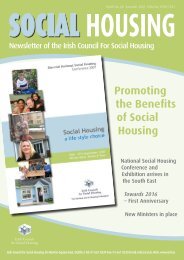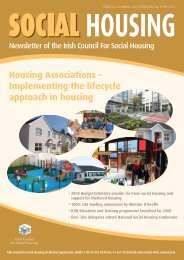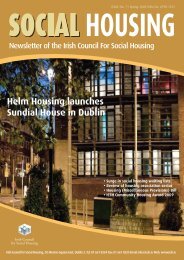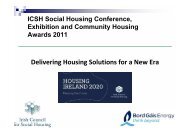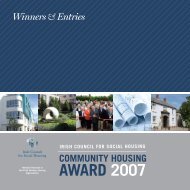National Housing Strategy for People with a Disability 2011 - 2016
National Housing Strategy for People with a Disability 2011 - 2016
National Housing Strategy for People with a Disability 2011 - 2016
Create successful ePaper yourself
Turn your PDF publications into a flip-book with our unique Google optimized e-Paper software.
10.8 The guiding principle of the working group is that ‘each client is a citizen of theState. No service provider, third party or the HSE own a client and can solely determine orcontrol the services and supports to be provided to that individual.’10.9 The key objectives of the working group were:• To identify the number of congregated settings and the numbers of people currentlyliving in these settings (defined as 10 or more persons); to develop a profile of theclient group in each setting in terms of numbers, age, nature of disability andsupport needs; and the costing of their current service;• To specify a framework to guide the transfer of identified individuals fromcongregated settings to the community, based on best practice and up to dateresearch;• To indicate the likely capital and revenue cost requirements of implementing thisframework;• To outline an overview of the current situation so that priorities, if necessary, can bedecided; and• To present the in<strong>for</strong>mation gathered in this process to aid in the future direction offuture policy development in terms of the living arrangements <strong>for</strong> people <strong>with</strong>disabilities.10.10 This group defined congregated settings as living arrangements (whose primarypurpose is the provision of services to people <strong>with</strong> intellectual, physical or sensorydisabilities) where ten or more people share a single living unit or where the livingarrangements are campus-based. Settings de-designated 105 under health legislation wereincluded under the terms of reference <strong>for</strong> congregated settings. <strong>People</strong> living in mentalhealth settings that are not de-designated were not included in the terms of reference of theworking group as the needs of this cohort are due to be addressed through theimplementation of the national policy on mental health services set out in A Vision <strong>for</strong>Change. <strong>People</strong> <strong>with</strong> disabilities living in nursing homes, in residential services <strong>for</strong> people105<strong>People</strong> living in units de-designated under either the Mental Treatment Act, 1945 or the Mental Health Act,2001 were included in the scope of the project. The term ‘de-designated unit’ usually refers toaccommodation on the grounds of psychiatric hospitals. The de-designated units are dedicated intellectualdisability services <strong>with</strong> a separate management structure to the psychiatric structure on the same campus.126



